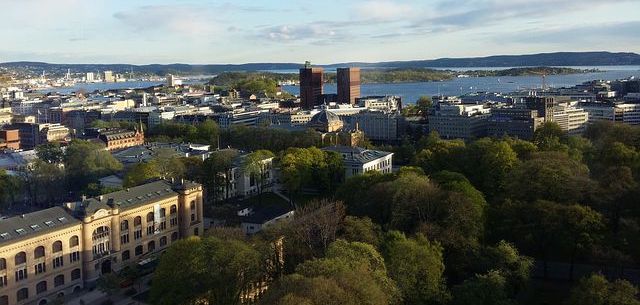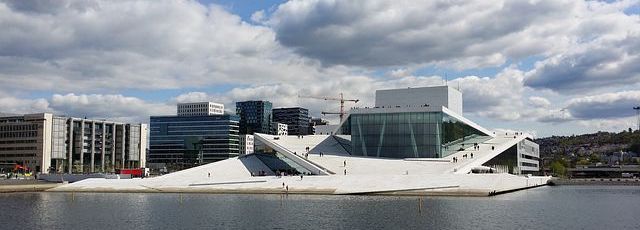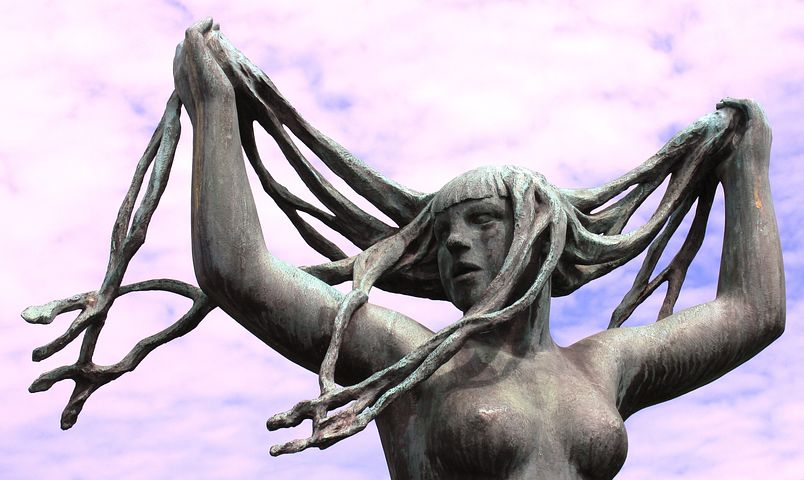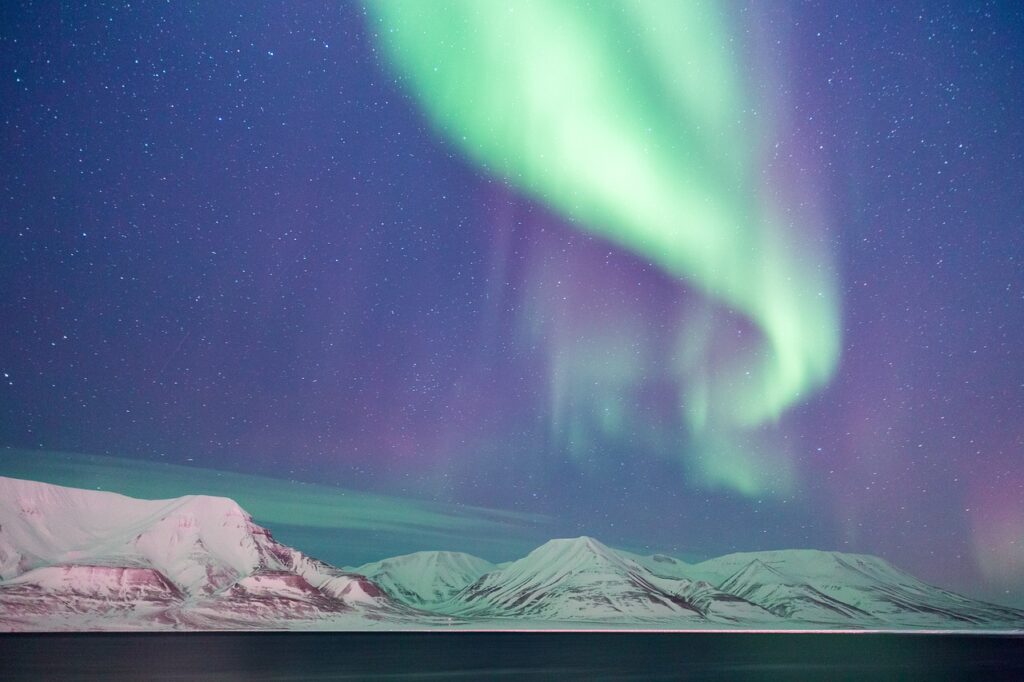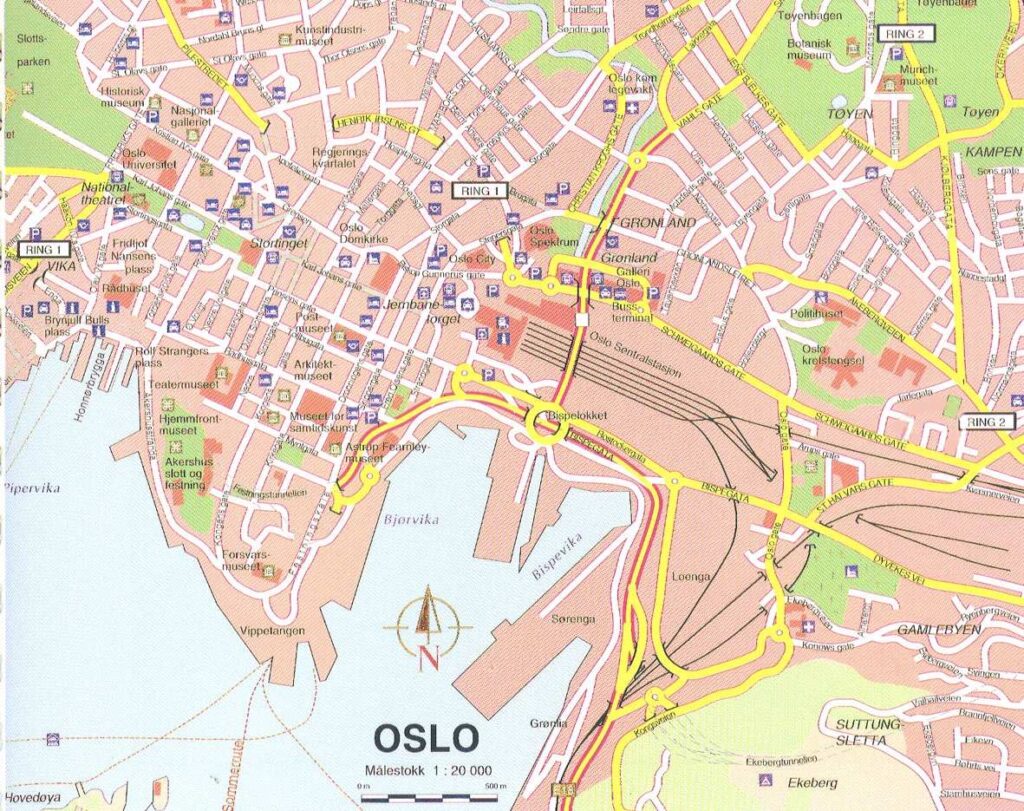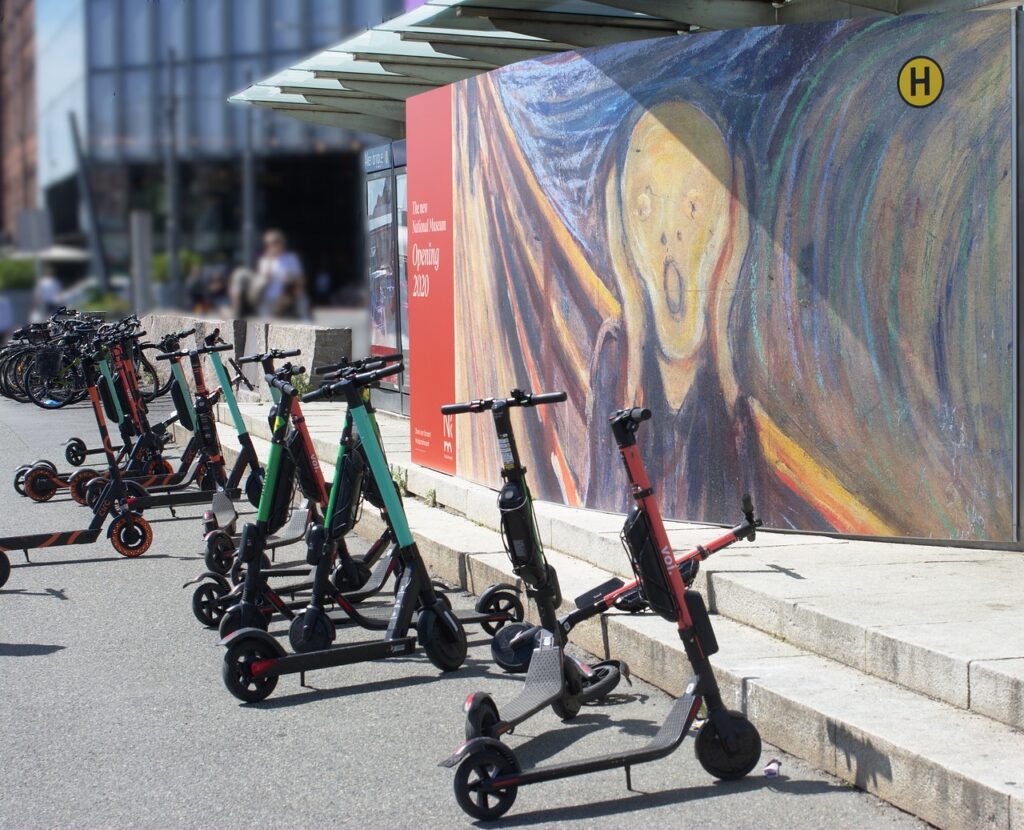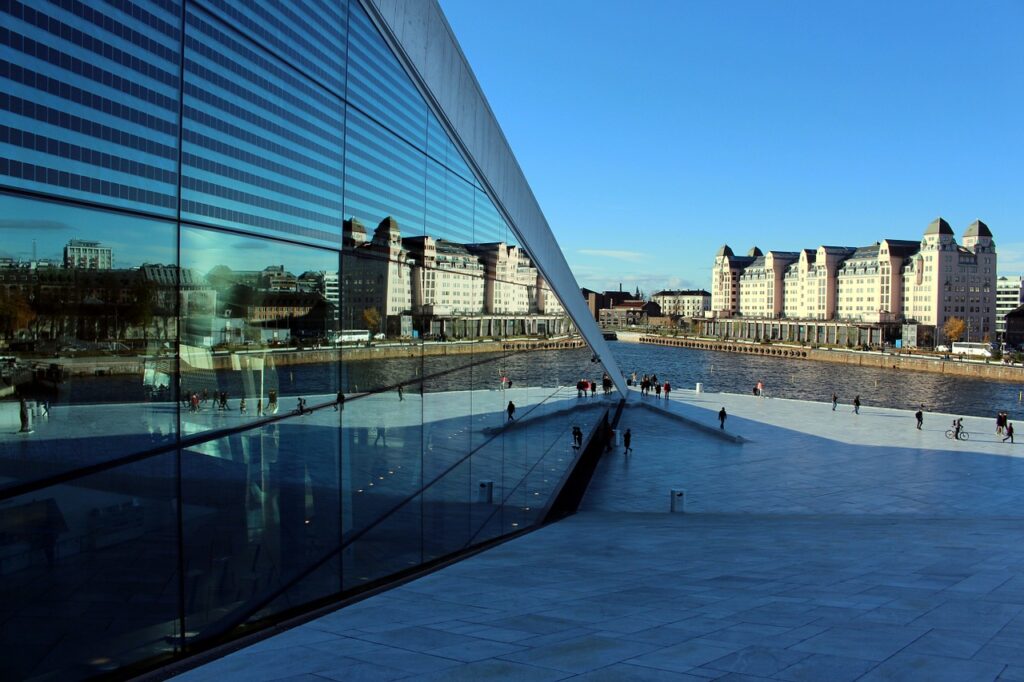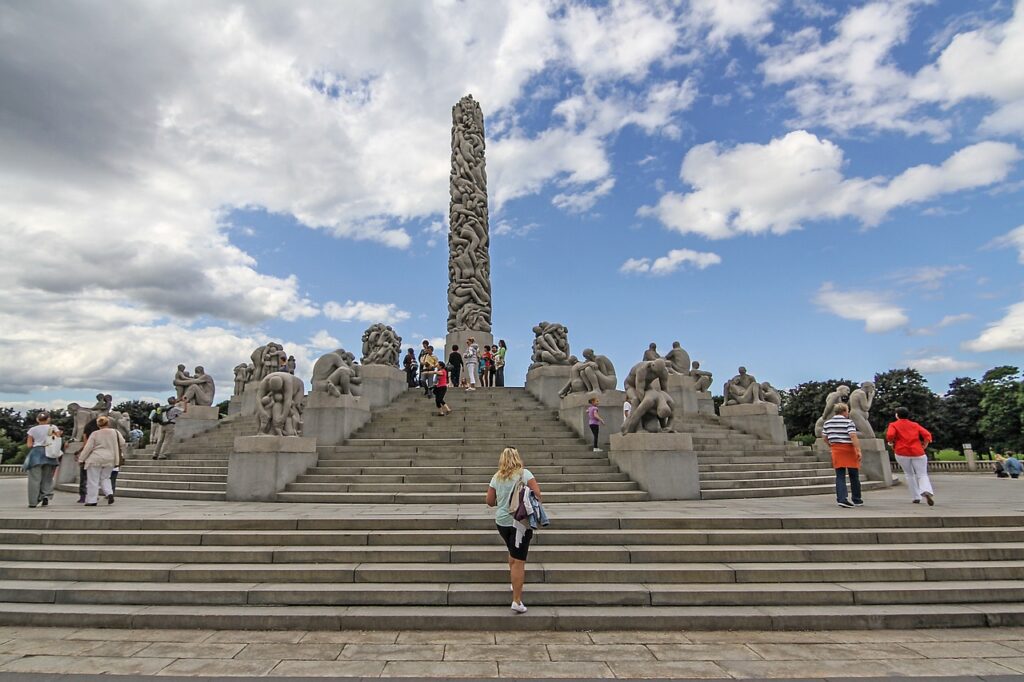I love Oslo, which I have visited many times, teaching feng shui over the years. Let me tell you why Oslo has good feng shui.
A very short history of Oslo: it was founded in 1050 by Vikings, devasted by the black death in 1350, destroyed in a fire in 1624 and then rebuilt in stone and renamed Christiania by Christian IV, and became the capital of Norway in 1814 and given the current name in 1925. Oslo has given us the pop group Aha, cheese slicer and paperclip as well as the ‘The Scream’ by Edvard Munch and works by Henrik Ibsen (1828-1906). Oslo is one of the best cities to live in, with low unemployment, good water, clean air and, therefore, good feng shui.
The water element of Oslo
Oslo is made up of 14 islands. You can take a short trip to see some of them and, in the process, look at the interesting architecture of Akershus Castle and Fortress. One island, Lindøya, by law, has to have all houses painted in three colours: green, red and yellow, which were decided based on the five-element cycle (it looks like :).
The drinking water quality is amazing. I used to bring mineral Norwegian water that comes from glaciers on the plane to London. Another thing I once brought to the UK was a very smelly fish called rakfisk, which is a fish naturally fermented for months, if not years. Rakfisk has very strong yang energy. Hence, Vikings loved it on their long journeys (but I got strange looks when I was buying it in the fish shop because not many people dare to eat it). I must admit it was worth it because after eating it, I immediately got a few very well-paid feng shui jobs, so the ‘yang effect’ worked.
Oslo’s geography, composed of 14 islands, significantly represents the water element. This element is associated with wisdom, fluidity, and adaptability. The presence of islands and the quality of drinking water, which is exceptional due to its glacial origins, exemplify the nourishing and life-sustaining qualities of water in Feng Shui. Moreover, the tradition of painting houses in Lindøya in colours aligned with the five-element cycle reflects a conscious integration of Feng Shui principles in urban planning.
Interesting buildings and architecture with good feng shui
The Thief is an interesting (quite expensive) hotel located on Tjuvholmen (‘Thief’) Island. At the entrance, you’re met with a sculpture by Sir Antony Gormley, and the whole hotel is full of contemporary art. The works by Damien Hirst, Jeff Koons, Richard Price and Sir Peter Blake, who designed one of the rooms in which Bill Gates, Jay-Z and Rihanna stayed (his art is featured heavily there with “Sonja Henie” where he used real diamond dust). The Thief is dog and child-friendly, with assigned rooms for pets and children and specially designed premium equipment such as beds, cribs and dining chairs.
The Renzo Piano-designed Astrup Fearnley Museum of Modern Art is nearby, as is the Aker Brygge harbour. The city centre is about a 15-minute walk.
The wood energy
Vigeland Park is probably the largest sculptural park with just one artist, boasting over 200 pieces (The collection, dubbed “The Weirdest Statues in the World” by The Daily Mail). In the 1920s, the artist Gustav Vigeland gave all his works, which are in bronze, granite and wrought iron, to the city of Oslo. The park was built between 1939 and 1949. The ‘Angry Boy’ (1928) sculpture is worth seeing, and rub his hand to boost your luck factor. The highlight is the 14.12m high monolith carved from a single 240-ton block of stone (it took three stonemasons and 14 years to complete).
Vigeland Park, with its extensive collection of sculptures, represents the wood element. This element is connected to growth, vitality, and renewal. The park’s role as a public space filled with artistic expression and natural materials (bronze, granite, iron) aligns with the wood element’s attributes of creativity and expansion. The park’s open, natural environment and the artistic legacy it houses contribute to a sense of continuous growth and evolution, key aspects of the wood element.
The fire energy
Art has fire energy, and Edvard Munch’s The Scream or Skrik (one of the four versions painted in 1893; in 2012, one copy sold for £74m, and it is said the Home Alone movie borrowed it for one scene) can be seen at The National Gallery. The fire element, associated with dynamism, passion, and visibility, is represented through Oslo’s rich artistic heritage, notably Edvard Munch’s “The Scream.” Art, especially of the intensity and fame of “The Scream,” embodies the transformative and expressive qualities of the fire element. This element is about visibility and recognition, and Munch’s work, being globally renowned, significantly contributes to this aspect of Oslo’s Feng Shui.
Plasma is also fire energy
In contemplating the energetic nature of plasma and its manifestation in phenomena such as the Northern Lights, particularly in the context of Norway, one embarks on a fascinating journey through both physical and metaphysical landscapes. Plasma, often described as the fourth state of matter, indeed embodies the qualities of fire energy in a multitude of ways. This assertion invites a thorough exploration, intertwining the principles of physics with the more abstract realms of energy conceptualization.
The Nature of Plasma and Fire Energy
Plasma is a state of matter where the gas phase is energized to the extent that atomic electrons are dissociated from their nuclei, leading to a soup of charged particles: positively charged ions and negatively charged electrons. In this sense, plasma is akin to fire, which is also a highly energised state of matter. Both plasma and fire emit light and heat, exhibit fluid-like dynamics, and possess transformative power in their respective environments.
Fire, in traditional and metaphysical contexts, is often associated with energy, transformation, and renewal. This aligns well with the properties of plasma, which is ubiquitous in the universe, forming stars and facilitating cosmic phenomena. Plasma’s intrinsic ability to conduct electricity and respond to magnetic fields also endows it with a dynamic and transformative nature.
The Northern Lights: A Celestial Dance of Plasma
Turning our gaze towards the Northern Lights, or Aurora Borealis, particularly as observed in the Nordic climes of Norway, we encounter a spectacular demonstration of plasma’s fire energy. These lights are a result of solar winds interacting with Earth’s magnetosphere. Charged particles from the sun, primarily electrons and protons, travel towards Earth and are guided by its magnetic field towards the polar regions.
Upon reaching the higher atmosphere, these solar particles collide with gases like nitrogen and oxygen. This collision excites the atmospheric gases to a plasma state, leading to the emission of light – a process not unlike the light emission in a neon sign. The different colours of the aurora are due to the varying wavelengths of light emitted by different gases when they return to their ground state.
Metaphorical and Spiritual Interpretations
In a metaphorical sense, the Northern Lights can be seen as a bridge between the earthly realm and the cosmic, a visual symphony that speaks of the interconnectedness of all matter and energy. This celestial phenomenon, with its ethereal beauty and fluid, dynamic motion, resonates with the principles of transformation and energy flow, concepts that are central to spiritual and personal development practices, including those within the domains of meditation and feng shui.
Implications for Personal and Spiritual Development
For individuals engaged in spiritual health coaching or personal development, the phenomena of plasma and the Northern Lights serve as powerful metaphors. They illustrate the principles of energy transformation and the dynamic interplay between different states of being. Just as plasma transitions from one state to another, so too can individuals experience transformation and renewal in their personal and spiritual journeys.
In conclusion, the study of plasma, especially in the context of the Northern Lights in Norway, offers a rich tapestry of insights that straddle the realms of physics, spirituality, and personal development. The fiery energy of plasma, manifesting in the celestial dance of the auroras, serves as a reminder of the dynamic and interconnected nature of the universe, providing a profound metaphor for transformation and renewal in both the physical and metaphysical worlds.
The energy flow of Oslo
Oslo has one of the oldest metros (it was opened in 1898) with five lines and 101 stations. If you’re visiting Oslo in winter, you can take the metro to the top of one hill for toboggan at 25km/hr, which is always fun. You can also try cross-country skiing (‘ski’ means ‘piece of wood’ in Norwegian) and burn 400-700 calories per hour.
Oslo’s efficient metro system, one of the oldest in the world, and its recreational activities, like tobogganing and skiing, reflect the dynamic flow of energy within the city. In Feng Shui, smooth and efficient movement within a space is crucial for maintaining balance and positive energy flow. The metro system, by facilitating easy movement around the city, and the outdoor activities, by encouraging physical engagement with the environment, both contribute to a healthy, vibrant energy flow in Oslo.
Oslo, with its unique blend of natural beauty and architectural innovation, offers several interesting aspects that can be connected to Feng Shui principles:
- Akershus Fortress: This historic site, located in the heart of Oslo, is a prime example of strategic placement in Feng Shui, known as the ‘command position’. The fortress is situated on a hill, providing a commanding view of the surrounding area, which is a key aspect of Feng Shui for protection and strength. Its proximity to water also balances the elements of earth (the fortress itself) and water, symbolizing prosperity and calm.
- Oslo Opera House: Designed to look like a glacier floating in the Oslo fjord, the Opera House is a beautiful example of the harmonious integration of architecture with the surrounding natural environment, a core principle in Feng Shui. Its sloping roof allows people to walk up and enjoy panoramic views, symbolizing openness and accessibility, important aspects of Feng Shui that promote positive energy flow (Chi).
- Barcode Project: This is a row of multi-purpose high-rise buildings that have transformed Oslo’s skyline. The alignment and shape of these buildings resemble a barcode, hence the name. In Feng Shui, vertical lines are often associated with growth and aspiration. The spaces between the buildings allow for the flow of energy, preventing the feeling of being cramped, which is essential for good Chi flow.
- Holmenkollen Ski Jump: This structure is not just an architectural marvel but also aligns well with Feng Shui principles. The ski jump, rising high into the sky, represents the Wood element, which is associated with growth and upward movement. Its position, high above the city, also resonates with Feng Shui’s emphasis on elevation for prosperity and fame.
- The Vigeland Installation in Frogner Park: The largest sculpture park in the world made by a single artist, this park is an excellent example of Feng Shui’s principle of balance and harmony in communal spaces. The human figures in various stages of life represent the cycle of life, resonating with the Feng Shui concept of the flow and balance of energy throughout one’s life.
- The Norwegian National Opera and Ballet: Apart from the Opera House, the institution itself is a symbol of cultural flow and dynamism, integral to Feng Shui’s focus on energy movement. The activities within, such as dance and music, are forms of dynamic energy which contribute to the city’s vibrant Chi.
- Tanum Litteraturhuset: Literary centre with spaces for reading, discussion & writing, plus a cafe and a program of events.
These architectural landmarks and their integration with the city’s natural landscape demonstrate how Oslo incorporates Feng Shui principles into modern urban design, creating a harmonious balance between the natural and the built environment.
Norwegian cuisine, with its unique flavours and ingredients, can be wonderfully analyzed through the lens of the Five Element Theory in Feng Shui. This theory, which underpins much of Feng Shui, correlates to five elements: Wood, Fire, Earth, Metal, and Water. Each element is associated with certain characteristics, flavours, and even colours, offering a holistic way to understand and balance our diet and environment.
- Wood Element: In Feng Shui, Wood is associated with growth, vitality, and flexibility. Foods that represent the Wood element are typically green and support liver health. In Norwegian cuisine, this can be seen in dishes like spinach soup or salads made with fresh, leafy greens. The use of fresh herbs like dill, commonly used in Norwegian cooking, also aligns with the Wood element.
- Fire Element: Fire symbolizes passion, energy, and dynamism. Foods that are spicy or bitter and are red or orange in color represent this element. Norwegian cuisine isn’t traditionally spicy, but the use of berries like cloudberries (bright orange) and lingonberries (red) can be seen as an incorporation of the Fire element. These berries, often used in desserts or as accompaniments, bring the vibrant, energetic qualities of Fire to the table.
- Earth Element: Earth represents stability, nourishment, and care. Foods that are yellow, orange, or brown and that are sweet and round often symbolize this element. Root vegetables, which are staples in Norwegian cooking, such as potatoes, carrots, and rutabagas, embody the Earth element. These grounding foods are often found in hearty Norwegian stews and soups, providing a sense of comfort and stability.
- Metal Element: Metal is associated with clarity, precision, and efficiency. Foods that are white or pungent fall into this category. In Norwegian cuisine, dairy products like Brunost (a brown cheese, but dairy nonetheless) and various white fishes, such as cod or haddock, represent the Metal element. These foods, with their clear flavours and essential nutrients, bring the qualities of Metal into the diet.
- Water Element: Water symbolizes wisdom, depth, and fluidity. Foods that are black or salty and those that are rich in water correspond to this element. Traditional Norwegian fish dishes, especially those involving salted or smoked fish like Gravlaks, are embodiments of the Water element. Additionally, the use of seaweed in some coastal Norwegian recipes adds both the colour and flavour associated with Water.
By understanding how Norwegian cuisine aligns with the Five Elements, one can appreciate not only the cultural richness of Norway’s culinary traditions but also the balance and harmony these foods can bring to our lives, in line with Feng Shui principles. This holistic view emphasizes the importance of a balanced diet, not just in terms of nutrients but also in terms of energy and harmony with nature.
Norwegian values
Norwegian culture is deeply rooted in values that emphasise equality, simplicity, and connection with nature, reflecting a societal framework that values collective wellbeing alongside individual freedom. These values are woven into the fabric of daily life and institutional practices, offering a lens through which Norwegian society can be understood.
- Equality (Likestilling): Norway is renowned for its commitment to gender equality and social equality. This commitment is manifest in various aspects of societal life, including a strong welfare state, equal opportunities in education and employment, and policies aimed at reducing income disparity. The notion of ‘Janteloven’ (the Law of Jante), a cultural norm discouraging individual boasting and highlighting the importance of community and equality, further underscores this value, although it’s also subject to criticism for potentially stifling individual achievement.
- Sustainability and Environmentalism: Norwegians have a profound respect for nature, which is reflected in their strong commitment to environmental protection and sustainability. This value is evident in policies aimed at conserving natural resources, promoting renewable energy, and encouraging sustainable practices among individuals and businesses. The country’s landscapes — from fjords to forests — play a central role in outdoor activities and national identity, fostering a collective responsibility towards environmental stewardship.
- Trust and Transparency: Norwegian society is characterised by a high degree of trust in government institutions, the legal system, and fellow citizens. This trust is underpinned by a transparent and accountable governance model, where open communication and public access to information are fundamental. The trust extends to everyday interactions, with a general expectation of honesty and integrity.
- Work-Life Balance: Norwegians place a strong emphasis on maintaining a healthy balance between work and personal life. This is facilitated by labour laws that ensure reasonable working hours, ample vacation time, and generous parental leave policies. The value placed on personal time is reflective of a broader cultural emphasis on wellbeing, family, and enjoying the outdoors.
- Simplicity and Modesty: Despite Norway’s wealth from oil and gas reserves, there is a cultural inclination towards simplicity and modesty in lifestyle and consumption. This is partly rooted in the Lutheran tradition, which values modesty and humility. The concept of ‘koselig’, similar to the Danish ‘hygge’, embodies the importance of simplicity, comfort, and warmth in creating a good quality of life.
- Innovation and Education: Valuing education and continuous improvement, Norway invests heavily in education, research, and innovation. The aim is to foster a knowledge-based economy and society that can adapt to changes and challenges, both locally and globally. This emphasis on education is also a means to uphold other societal values, such as equality and sustainability.
These values are not only integral to understanding Norwegian culture but also play a pivotal role in shaping policies and practices across various sectors. The interplay between these values and the country’s governance models offers rich insights into the societal structures that facilitate Norway’s high quality of life and social cohesion.
Famous Norwegians
Norway, with its rich history and cultural heritage, has produced many notable individuals who have achieved fame and recognition both nationally and internationally across various fields such as literature, the arts, exploration, and sports. Here are a few of the most famous Norwegians known around the world:
- Henrik Ibsen (1828–1906): Often considered one of the greatest playwrights since Shakespeare, Henrik Ibsen is known for his plays that tackled society’s norms and challenged the Victorian values of his time. His works, such as “A Doll’s House,” “Ghosts,” and “Hedda Gabler,” remain influential in the world of theatre and literature.
- Edvard Munch (1863–1944): A pioneer of the Expressionist movement in art, Edvard Munch is best known for his iconic painting “The Scream.” His work captures the human psyche and emotions with vivid colours and dramatic compositions, making him one of the most notable figures in modern art.
- Roald Amundsen (1872–1928): Renowned as a leading polar explorer, Amundsen was the first to navigate the Northwest Passage and also the first to reach the South Pole in 1911. His expeditions have been pivotal in the exploration of the Polar Regions.
- Fridtjof Nansen (1861–1930): An explorer, scientist, diplomat, and humanitarian, Nansen achieved fame by crossing Greenland’s interior ice in 1888. He later served as the League of Nations’ High Commissioner for Refugees, earning the Nobel Peace Prize in 1922 for his efforts in helping displaced victims of World War I.
- Thor Heyerdahl (1914–2002): An adventurer and ethnographer, Heyerdahl is famous for his Kon-Tiki expedition in 1947, where he sailed 8,000 km across the Pacific Ocean in a hand-built raft to demonstrate that ancient people could have made long sea voyages, creating contacts between separate cultures.
- A-ha: This pop band, consisting of Morten Harket, Magne Furuholmen, and Pål Waaktaar-Savoy, achieved worldwide fame in the 1980s with hits like “Take On Me,” which is renowned for its innovative music video featuring a blend of live-action and animation.
- Magnus Carlsen: Born in 1990, Carlsen is a chess prodigy who became World Chess Champion in 2013. Known for his deep understanding of the game and innovative strategies, he has dominated the world of chess for many years and is considered one of the greatest chess players of all time.
These individuals, among others, have left a significant mark on their respective fields, bringing attention to Norway’s contributions to global culture, exploration, and knowledge. Their legacies continue to inspire and influence people around the world.
Vikings and Feng Shui
If Vikings had been acquainted with feng shui principles, it’s fascinating to consider how they might have integrated these concepts into their own cultural practices and values, particularly in the context of building and situating their homes. Vikings did value their homes, known as longhouses, which were central to their familial and social life. These longhouses were not only practical structures for living and shelter but also held significant cultural and social importance, serving as a hub for family gatherings, celebrations, and meetings.
Integrating feng shui with Viking architectural and social principles might have led to a unique blend of respect for nature, strategic positioning, and the creation of harmonious living spaces. Here are a few ways Vikings might have applied feng shui principles:
- Alignment with Natural Elements: Vikings might have positioned their longhouses in harmony with the natural landscape, such as aligning them with the cardinal directions for optimal sunlight and protection against winds. Feng shui emphasizes the balance of the five elements (wood, fire, earth, metal, water), which could have been reflected in the materials used and the surroundings of Viking settlements.
- Entrance Placement for Positive Energy: The entrance of a Viking longhouse, facing away from prevailing winds, might have been considered to enhance the flow of positive energy (Chi) into the home, aligning with feng shui principles that emphasize the significance of the entrance to a home.
- Interior Layout for Harmony and Prosperity: Inside the longhouse, spaces might have been organized to promote a harmonious flow of energy, with sleeping areas placed for tranquillity and communal areas arranged to encourage social interaction and familial bonds, reflecting feng shui’s emphasis on the arrangement of space to enhance well-being and relationships.
- Symbols of Protection and Prosperity: Vikings might have incorporated symbols believed to bring protection, prosperity, and good fortune into their homes, akin to feng shui’s use of specific symbols and artifacts. For Vikings, these could have included runes, carvings of gods and mythical creatures, and other Norse symbols thought to offer protection and blessings.
- Respect for Nature and the Environment: Both Vikings and feng shui principles hold a deep respect for nature and the environment. Vikings might have chosen locations for their homes that not only provided strategic advantages but also lived in harmony with the land, reflecting feng shui’s emphasis on the interconnectedness of human beings and their environment.
In essence, if Vikings had known about feng shui, they might have embraced its principles to enhance the harmony, prosperity, and protection of their homes, melding their robust, nature-centric worldview with the nuanced, energy-focused insights of feng shui.
The presence of Feng Shui consultants and the application of Feng Shui in architectural and urban design in Oslo indicate a recognition and integration of these principles in modern living. This shows a blend of traditional wisdom with contemporary lifestyle, essential for a balanced and harmonious environment.
In summary, Oslo’s unique geographical features, rich cultural heritage, urban design, and lifestyle activities all contribute to its Feng Shui, each element playing a vital role in creating a harmonious and balanced environment.
Feng shui consultants in Oslo, Norway
There are feng shui consultants in Oslo. But if you live in Oslo and are looking for a feng shui consultant near you – with 30+ years of experience in feng shui, Vastu, and environmental psychology feel free to call/text me at +447956 288574 for a quote for feng shui consultation for your home or workplace. Although I live in London, I do remote virtual feng shui consultations. Or I can fly to Oslo in a couple of hours. Email me
Check my blogs about feng shui of cities

